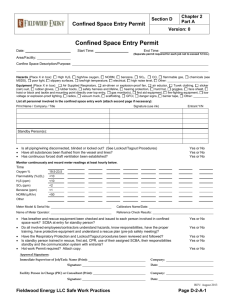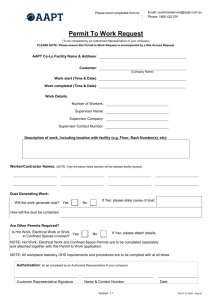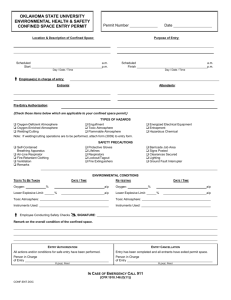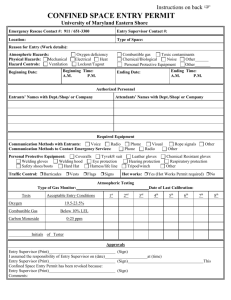, ENTRY INTO CONFINED SPACES
advertisement
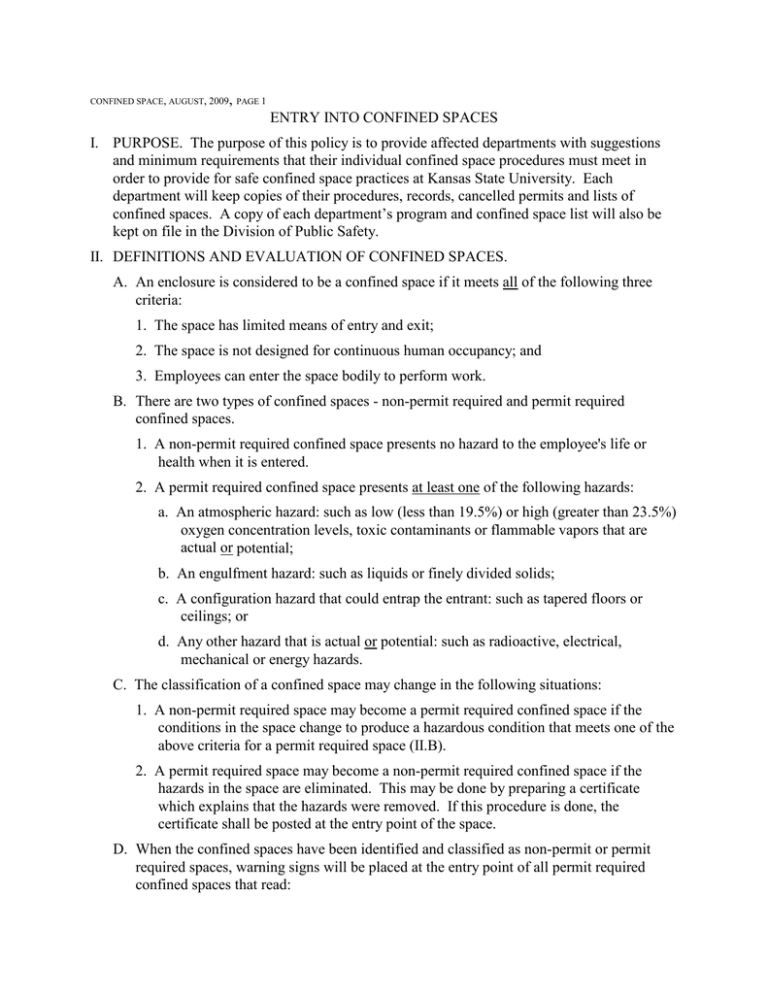
, CONFINED SPACE, AUGUST, 2009 PAGE 1 ENTRY INTO CONFINED SPACES I. PURPOSE. The purpose of this policy is to provide affected departments with suggestions and minimum requirements that their individual confined space procedures must meet in order to provide for safe confined space practices at Kansas State University. Each department will keep copies of their procedures, records, cancelled permits and lists of confined spaces. A copy of each department’s program and confined space list will also be kept on file in the Division of Public Safety. II. DEFINITIONS AND EVALUATION OF CONFINED SPACES. A. An enclosure is considered to be a confined space if it meets all of the following three criteria: 1. The space has limited means of entry and exit; 2. The space is not designed for continuous human occupancy; and 3. Employees can enter the space bodily to perform work. B. There are two types of confined spaces - non-permit required and permit required confined spaces. 1. A non-permit required confined space presents no hazard to the employee's life or health when it is entered. 2. A permit required confined space presents at least one of the following hazards: a. An atmospheric hazard: such as low (less than 19.5%) or high (greater than 23.5%) oxygen concentration levels, toxic contaminants or flammable vapors that are actual or potential; b. An engulfment hazard: such as liquids or finely divided solids; c. A configuration hazard that could entrap the entrant: such as tapered floors or ceilings; or d. Any other hazard that is actual or potential: such as radioactive, electrical, mechanical or energy hazards. C. The classification of a confined space may change in the following situations: 1. A non-permit required space may become a permit required confined space if the conditions in the space change to produce a hazardous condition that meets one of the above criteria for a permit required space (II.B). 2. A permit required space may become a non-permit required confined space if the hazards in the space are eliminated. This may be done by preparing a certificate which explains that the hazards were removed. If this procedure is done, the certificate shall be posted at the entry point of the space. D. When the confined spaces have been identified and classified as non-permit or permit required spaces, warning signs will be placed at the entry point of all permit required confined spaces that read: , CONFINED SPACE, AUGUST, 2009 PAGE 2 DANGER PERMIT REQUIRED CONFINED SPACE DO NOT ENTER or similar language. III. HAZARD IDENTIFICATION. A. The Division of Public Safety will advise departments if they oversee areas that are considered to be confined spaces. B. Each required department shall conduct a walk -through of their facilities with or without Public Safety Officials and determine what confined spaces exist, where they are located, their classification as either a non-permit or permit required confined space based on the definitions of in paragraph II above, and the hazards that exist in that space. C. The findings of the evaluation shall be reported to the Division of Public Safety and also kept on record in the individual department. D. In grain storage facilities, the requirements of 29 CFR Part 1910.272 will be followed to manage entry hazards involving grain engulfment, combustible dust, and electrical/pneumatic/hydraulic mechanical equipment. Entry hazards from pesticides will be managed according to the applicable pesticide label. Any remaining recognized entry hazards will be managed according to this confined spaces policy. IV. EQUIPMENT. It is the responsibility of the individual department to provide its employees with the proper equipment needed to perform work in a permit required confined space. The following equipment list includes possible required items: A. Atmospheric monitoring instruments - these instruments can be personal monitors worn by entrants, calorimeter tubes or other such calibrated direct reading instruments that meet the requirement of OSHA in 29 CFR 1910.146(c)(5)(ii)(C). B. Respirators - shall be worn when needed and must provide appropriate protection for the work environment. C. Rescue equipment - this may include a lifeline, harness, wristlets, ladders etc. which aid in the rescue of an employee. This equipment must be on site for non-entry rescues and available to the outside rescue team for entry rescues. D. Hard hat - when needed E. Gloves - when needed F. Non-sparking tools - when needed G. Explosion proof lighting - when needed V. ENTRY PROCEDURES. Each department may develop its own forms and procedures which meet the following requirements. The permit shown on page 8 can be used. Names of supervisor, entrants, and attendants must be provided, not just titles. , A. Roles of Individuals CONFINED SPACE, AUGUST, 2009 PAGE 3 1. Entry Supervisor: a. Know the hazards that the entrant may encounter during the entry, and know the symptoms of exposure to those hazards; b. Complete the entry permit and verify that all tests required have been conducted, all procedures have been followed and all equipment is in working order and in place as required by the permit. When the requirements of the permit are met, the supervisor shall sign the permit and then allow entry into the space; c. Cancel the permit and terminate entry when the permit expires or evacuation of the space is necessary; d. Verify that the rescue team can be summoned if needed; e. Verify that the conditions remain consistent with the permit requirements; f. Inform outside contractors of the confined spaces that exist, the hazards associated with the spaces and ensure they understand the policies and procedures for working in the permit required confined spaces; and g. Coordinate operations with the outside contractor when both host employer personnel and contractor personnel will be working in a permit required space. 2. Authorized Entrant(s) a. Know the hazards that may be encountered in the space and the symptoms of exposure to those hazards; b. Know how to properly use the equipment required; c. Communicate with the attendant while working in the space; d. Alert the attendant when an unacceptable condition arises; e. Exit the space when necessary to do so; and f. Know and understand the policies and procedures for permit required confined spaces developed by Kansas State University. 3. Attendants: a. Know the hazards that the entrant may encounter during the entry, and know the symptoms of exposure to those hazards; b. Maintain a count of authorized entrants in the space while work is being performed. c. Allow only authorized entrants to enter the permit required confined spaces; d. Communicate with the entrant(s) while they are working in the space; e. Monitor the activities both inside and outside of the space for changing conditions; f. Order an evacuation when necessary; , g. Remain stationed outside of the permit required space - DO NOT enter the space and DO NOT leave unless relieved by another attendant. THERE MUST BE AN ATTENDANT AT ALL PERMIT REQUIRED CONFINED SPACES WHEN ENTRANTS ARE IN THE SPACE WORKING; CONFINED SPACE, AUGUST, 2009 PAGE 4 h. Perform non-entry rescues when necessary and feasible; and i. Notify the designated rescue team if an emergency arises and an entry rescue is necessary. 4. Outside Contractors: a. Know and understand the policies and procedures of the host employer for entry into a permit required confined space; b. Know the hazards that may be encountered while working in the permit required space; c. Know the safety procedures of the host employer; d. Know the emergency procedures of the host employer; e. Participate in a debriefing session with the host employer at the conclusion of the entry; and f. Coordinate operations with the host employer when both host employer personnel and contractor personnel will be working in the permit required confined space. g. Identify the Entry Supervisor, Authorized Entrants, and Attendants. B. Rescue Procedures 1. Non - Entry Rescues shall be performed by the attendants through the use of a harness and lifeline placed on the entrant before entry. The rescuer shall not enter the permit required confined space to perform a rescue. If entry is necessary to rescue an entrant, the attendant shall summon the outside rescue team to respond to the emergency. 2. The Outside Rescue Team will respond to emergencies where entry into the permit space is necessary. Each department will develop rescue procedures that fits its facilities. On-campus departments shall use the Manhattan Fire Department for entry rescues. Advise the rescue team when entry into permit space is planned. C. Atmospheric Testing 1. A hazardous atmosphere is one which may cause injury or illness to employees working in a confined space because of: a. flammable gas, vapor or mist that is > 10% of its LFL; b. airborne combustible dust at a concentration at or above its LFL; c. oxygen concentration < 19.5% or > 23.5%; d. atmospheric concentration of any substance for which a dose or permissible exposure limit is published in Subpart G, Occupational Health and Environment , Control, or in Subpart Z, Toxic and Hazardous Substances, of this Part and which could result in employee exposure in excess of its dose or permissible exposure limit; or CONFINED SPACE, AUGUST, 2009 PAGE 5 e. any other atmospheric condition that is immediately dangerous to life or health. 2. The atmosphere in a permit required confined space shall be tested: a. Before entering the space; and b. At several intervals while work is being done in the space. c. THERE MAY BE NO HAZARDOUS ATMOSPHERE IN THE SPACE WHEN EMPLOYEES ARE IN THE SPACE. 3. Atmospheres shall be tested for oxygen first, combustible gases second and toxic gases and vapors last. 4. The atmosphere shall be tested at all levels - bottom, middle and top - to check for stratified atmospheres. 5. The acceptable levels are as follows: Oxygen 19.5 - 23.5% Flammable gas, vapor or mist <10% LFL Toxic gas or vapor CO <35 ppm H2S <10 ppm 6. Instruments to be used shall be determined by the department to fit their needs and must be chosen in accordance with OSHA requirements (refer to section IV.A.) of this document). D. Entry Permit. Each department is responsible for developing an entry permit which contains the required information discussed below. 1. The permit may be pre-printed (an example may be found in Appendix A); 2. The permit must be completed and verified before entry is allowed and must contain the following information: a. permit required space to be entered, including its type (ex: sewer, vat, silo, etc.) ; b. Purpose of the entry - what work is to be performed; c. Date and duration of entry (permit expiration date, which is not to exceed the amount of time necessary to complete the work); d. Authorized entrants - first and last names; e. Attendants - first and last names; f. Entry supervisor - first and last name; g. Known and potential hazards of the permit required space; h. Isolation procedures; , i. Acceptable entry conditions; CONFINED SPACE, AUGUST, 2009 PAGE 6 j. Initial atmospheric test results and interval test results; k. Outside rescue team phone number and person to contact; l. Equipment required to meet entry requirements such as Personal Protective Equipment, harness, lifeline, monitoring and communications equipment; and m. Any additional permits issued such as hot work permits. 3. The entry permit shall be cancelled in the following situations: a. When the work inside the permit space is completed; b. When the conditions inside the permit space change which causes an unacceptable condition to arise; and c. When an emergency occurs. E. Permit System. Each department shall develop a permit system. 1. The entry supervisor will complete the confined space entry permit. 2. The supervisor will sign the permit to verify that all entry conditions have been met according to the permit requirements. 3. The entry supervisor will review the permit with the entrants and attendants to confirm that all entry conditions have been met. The permit will then be made available by posting it at the entry point or another effective and accessible location. 4. The duration of the permit shall not exceed the amount of time required to complete the work listed on the permit. 5. The entry supervisor terminates the entry and cancels the permit when: a. the work is completed or b. conditions develop that are not acceptable by the requirements of the permit. 6. The entry supervisor will note any problems or comments about the entry, permit, duties of individuals etc. on the permit to facilitate the required annual review of the system. 7. The entry permits will be kept for at least one year. F. Ventilation. Each department shall develop ventilation procedures which, at a minimum, must meet the following requirements; 1. Continuous forced air ventilation will be provided to eliminate potential hazardous atmospheres for all entries into permit required confined spaces. 2. This forced air flow will be directed to the immediate are where the entrant will be working and will continue until all entrants have left the permit space. 3. The air supply source will be clean and nonhazardous. G. Isolation. The department shall develop a system for isolation of spaces before entry. , This may be by means of temporary barriers, railings or covers to prevent accidental falls into the space and to protect the entrants from foreign objects entering the space. CONFINED SPACE, AUGUST, 2009 PAGE 7 H. Emergency Operations. In the event of an emergency operation, properly trained and adequately protected individuals may enter confined spaces where hazardous atmospheres exist. As a minimum, adequately protected means the use of supplied air respirators. Other personal protective equipment may be necessary depending on the hazard. VI. TRAINING. A. Training for entrants, attendants, entry supervisors, and rescue teams must be completed before the employees duties begin. Training is to be obtained either through the individual department or the Division of Public Safety and must meet the minimum requirements. B. Employees must know and be certified to perform the duties listed in section V.A. of this document. C. Training shall be provided: 1. before an employees is first assigned duties involved with a confined space; 2. before a change in assigned duties; and 3. when policies are changed. D. Training will be verified through a certification process. The department shall retain a record of all training for each employee involved in confined space operations. The record shall, at a minimum, include the employee's name, date and type of training received, and the signatures of the employee and the trainer. VII. ANNUAL REVIEW. The confined space policies and procedures shall be reviewed annually by the department. , CONFINED SPACE, AUGUST, 2009 PAGE 8 APPENDIX A Confined Space Entry Permit Location of space:___________________________________________________ Date:___________ Time:_____________ Expiration:_________________ Purpose of entry:____________________________________________________ Authorized Entrant(s):____________________ ____________________ Attendant(s):___________________________ ____________________ Entry Supervisor:________________________ Hazards:___________________________________________________________ Rescue contact:_________________________ Phone #:____________ MONITORING: Acceptable Level Reading Time Reading Time Oxygen (19.5-23.5%) _______ ____ _______ ____ Combustibles (< 10% LFL) _______ ____ _______ ____ CO (< 35 ppm) _______ ____ _______ ____ H2S (< 10 ppm) _______ ____ _______ ____ Instrument Used:____________________ Calibrated:_____________ Tester:____________________ Date:_____________ Time:_____________ EQUIPMENT: Lockout/Tagout yes no Tripod yes no Ventilation yes no Lifelines yes no Isolation yes no Radios yes no Respirators yes no Other PPE yes no SCBA yes no Hard hat yes no Fire extinguisher yes no Goggles yes no Lighting yes no Ear plugs yes no Harness yes no Other Permits yes no Entry supervisor's signature, authorizing the above conditions have been met for safe entry:_________________ Date:________ Time:_________ Time of cancellation:_______________ Comments:_________________________________________________________
